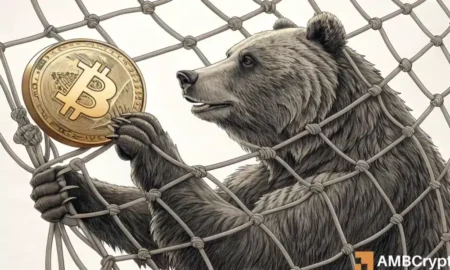The Struggles of MemeCore: A Deep Dive into the Memecoin Market
The memecoin market has taken a substantial hit recently, with a notable 5.6% downturn affecting numerous assets, including MemeCore (M), which serves as a critical infrastructure layer for memecoins. As a result, investors have begun to remove it from their watchlists. At the time of this report, CoinMarketCap indicated a staggering 30% plunge in MemeCore’s value, reflecting the broader bearish sentiment permeating the market.
Understanding Market Sentiment and Trends
The current decline in MemeCore can largely be attributed to an influx of negative sentiment among investors. Short traders have gained the upper hand, capitalizing on the market’s downturn. The analysis of market metrics such as the Funding Rate and Open Interest (OI) reveals a troubling trend—the OI-Weighted Funding Rate has turned negative, at -0.4946%. A negative reading of this magnitude indicates a strong bearish outlook, suggesting that most contracts are now held by short traders. Additionally, a significant $11.1 million inflow of capital has fueled short positions, amplifying the market’s downward trajectory and showcasing increased pessimism among investors.
Green Shoots of Optimism
Amid the turmoil, encouraging signs are beginning to surface. Recent Community Sentiment data indicates a noticeable uptick in investor optimism. Conviction has increased from a low 32% to nearly 64% within just a day. This rising optimism could signify a shift in market dynamics, as some bullish participants appear to be influencing the overall sentiment. Investors may begin to reconsider their positions, possibly stabilizing or even reversing the recent downturn.
Analyzing MemeCore’s Demand Zone
The recent price decline in MemeCore has pushed it into a crucial demand zone on financial charts. This zone has historically indicated strong buy pressure and often precedes asset rallies. Utilizing Bollinger Bands reveals that MemeCore has reached the lower band area, another traditional signal for potential upward movement. Moreover, the presence of an unfilled buy order pool, characteristic of demand zones, bolsters the near-term bullish outlook for MemeCore. However, it’s essential to consider the Parabolic Stop and Reverse (SAR) indicator, which currently shows downward pressure, suggesting that despite being in a demand zone, MemeCore could still face challenges before any significant recovery.
Market Volatility and Retail Investor Impact
While the demand zone suggests potential stabilization, factors contributing to ongoing selling pressure remain prevalent. Total market volume sits at $40.15 million, with retail investors accounting for approximately $40,000 in sales. Although this amount appears minor against the backdrop of derivatives activity, it is indicative of the psychological elements affecting price movements and suggests that further declines might be on the horizon. The dominance of derivatives traders in steering market direction underlines the precariousness of the current situation, as bearish sentiment continues to prevail until the overall sentiment shifts.
Looking Ahead: Can MemeCore Hold Its Ground?
The future trajectory of MemeCore remains uncertain. With the overall market sentiment heavily skewed toward bearishness and technical analysis suggesting a potential drop to the $1 mark, caution is warranted. The ability of MemeCore to hold within its key demand zone will be critical. Failure to maintain these levels could lead to further declines, while any bullish retracement relies on confirmation from relevant market indicators.
In Conclusion: Navigating a Bearish Landscape
In summary, MemeCore’s recent struggles highlight the volatile nature of the memecoin market. Driven by negative sentiment, particularly from derivatives investors, the potential for further downside exists. However, budding optimism from a shift in community sentiment offers a glimmer of hope. Careful monitoring of key levels and indicators will be crucial in determining whether MemeCore can rebound or if it will continue its downward trend in a difficult market landscape. As the situation evolves, investors will need to remain vigilant and adapt their strategies accordingly.














